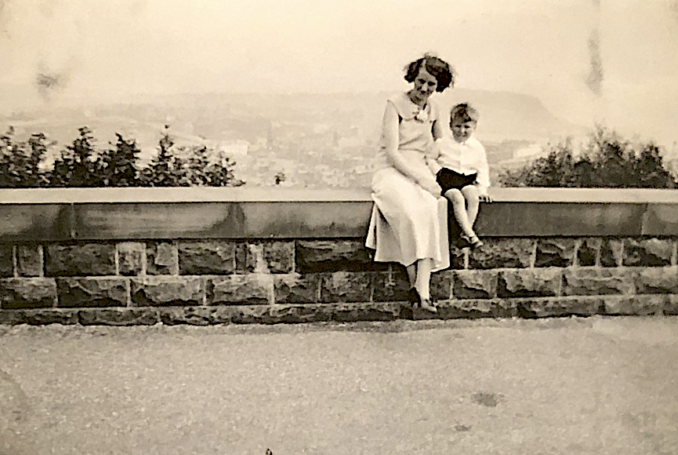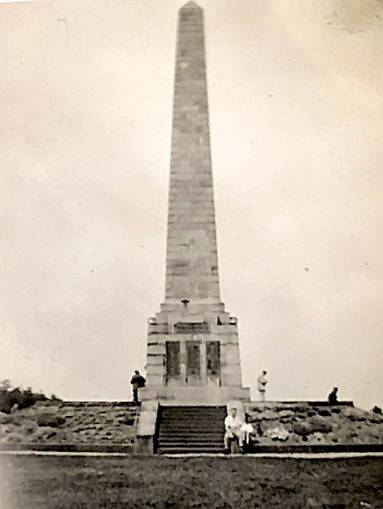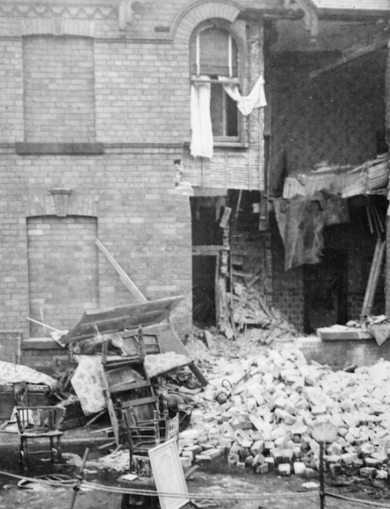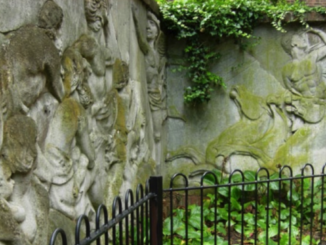Scarborough is a renowned seaside town located in North Yorkshire. It is the most populous town on the Yorkshire coast with a population in the sixty thousands. The town has a rich historical background, with evidence suggesting Viking and Roman settlements. During the Middle Ages, it served as a crucial trading hub, hosting the famous Scarborough Fair.
Scarborough is also known for its vibrant tourism industry. It offers traditional seaside fun, a variety of local shops, eateries, and beautiful gardens. Key attractions include the Scarborough Sea Life Sanctuary and the imposing Scarborough Castle.
Despite facing periods of destruction, such as during the English Civil War, Scarborough has continually rebuilt and evolved, maintaining its vibrancy and allure for residents and visitors alike. Visitors that included during the summer of 1936, a mere 87 years ago, my grandparents, my infant father and the family camera.
Tumultuous 1936
As my father and grandmother sat before the camera, England was part way through a tumultuous 1936. The year was marked by a number of significant events. It began with the death of King George V and the subsequent ascension of his son, Edward VIII, to the throne. However, Edward VIII’s reign was brief as he proposed to marry Wallis Simpson, the American socialite and double divorcee. This led to a constitutional crisis given the religious, legal, political, and moral objections by the governments of Great Britain and the Empire. Edward VIII abdicated in December of that year, leading to his brother Albert becoming King George VI.
The year also witnessed England’s first win over the All Blacks in rugby union and the premiere of the GPO Film Unit documentary Night Mail. Other noteworthy events included the test flight of the Supermarine Spitfire, the maiden voyage of the RMS Queen Mary and the Skegness opening of the first Butlins holiday camp. A subsequent one was to open at Filey (seven miles from Scarborough) in 1939 – just in time to be requisitioned as an army camp.
Added to which the General Post Office introduced the speaking clock and Fred Perry won his third successive men’s singles tennis title at Wimbledon. Besides the abdication, the year ended with a significant protest, the Jarrow March, where miners protested against unemployment and poverty. Wisely, Lord Macmillan’s ‘finest men in the world’ avoided the English seaside in October and when passing through the North Riding marched via Ripon and Harrogate.
Scarborough War Memorial

© Always Worth Saying 2023, Going Postal
Scarborough sits across two bays, South and North, with a 12th-century castle (hidden behind my grandmother) standing on the headland that separates the two.
My three-year-old father looks chubby and well. He smiles below a shock of blonde hair while wearing a crisp white shirt and dark shorts. By contrast, my grandmother looks gaunt and unwell. Her arms are thin, her head bowed, her hair unkempt. I had to take a second look at the family tree when it informed me she was only in her twenty-sixth as the shutter clattered. Tumultuous times indeed. Born in 1910, her childhood included the war to end all wars. Her teenage years and early adulthood saw an economic crash and the Great Depression.
Mother and son sit on a confident wall of faced copping atop three courses of unfaced but perfectly trimmed blocks. For before them and behind the photographer stands the Scarborough War Memorial built upon Oliver’s Mount which defines the end of the South Bay.
In February 1922, after months of discussion and the turning down of various suggestions, a war memorial scheme had at last been decided upon for Scarborough. Bronze tablets in the Town Hall or a monument at St Nicholas’ Cliff had been referred to the War Memorial Committee but rejected in favour of the erection of an obelisk over 80 feet in height 500 ft above sea level on the summit of Olvier’s Mount. Built of Portland Stone, the scheme also included the construction of steps and pathways from the base of the mount to the monument and the laying out of footpaths around it.

© Always Worth Saying 2023, Going Postal
By January of the following year, a meeting of the Scarborough War Memorial Committee reported that subscriptions of £4,069 had been raised allowing, when expenses were taken into account, £4,000 to remain at the disposal of the committee for the construction of the obelisk. Extra terraces would be constructed around the base of the memorial. The Borough Engineer had submitted this amended scheme which would cost an additional £1,000 with the townspeople asked to make an effort to ‘subscribe to this sum’.
Unveiled on September 26, 1923, the memorial features a stone obelisk mounted on a square pedestal on a square mound. Eleven steps leading up to it. Nowadays the memorial is recognized as Grade II listed structure on the National Heritage List for England.
We must assume the figures to the bottom right of the steps are my father and grandfather. Especially poignant as my grandfather’s older brother, my great uncle, was killed in the First War. Only seven years after this photograph was taken, his only son, my grandfather’s nephew, was to be killed in the Second War. To make the story even more complicated, following a recent DNA test, research into a gap in the family tree shows my grandfather’s mother to have been half-German. An interesting tale for another time.

© Google Street View 2023, Google.com
In the modern day, the memorial looks magnificent, leading the eye to the heavens from a trail of bright red poppy wreaths around the base. The plinth on which it stands, an exposed point high above the cliffs of a northeast port, is not the best place for flower beds. These have been filled in. Between the poppies and the tapering obelisk, those bronze tablets remember over 700 Scarborians killed in two world wars and the Korean War. Included are 53 civilians lost in one of the First World War’s most unlikely engagements.
December 16th 1914
Only weeks into the war, on December 16, 1914, Scarborough experienced a significant event that marked a shift in warfare. The town was attacked by two German battleships led by Rear Admiral Franz von Hipper who had been seeking opportunities to isolate and destroy sections of the British Royal Navy’s Grand Fleet. The German group also included other vessels; armoured cruisers, light cruisers, and destroyers including the Derfflinger and Von der Tann. This attack, known as the Raid on Scarborough or the Bombardment of Scarborough, was a momentous event as it was the first time civilians had been targeted on English soil during the war.
The attack on Scarborough began in the morning, with German warships firing on the undefended town causing significant damage. The raid lasted for 45 minutes, resulting in casualties on both sides. The German High Seas Fleet faced a retaliatory response from the British Grand Fleet, which had been alerted by intelligence about the German squadron’s departure from port.
The attack led to the destruction of Scarborough Castle’s coastguard’s lookout shelter and damage to the castle’s great tower and south-facing walls. This shocking event not only left physical scars on the town but also had a profound impact on the nation, leading to a recruitment campaign.
The raid was not completely unexpected. For some weeks previously, East Coast towns had been making preparations. Lord Kitchener had visited Scarborough. Nearly every road leading to the sea had wire entanglements erected. Yards of barbed wire had been crossed and re-crossed to make effectual and spikey barricades about six feet in height across the roads. In principle thoroughfares there were also sandbag barricades to a height of about eight feet with holes within them at intervals to allow for guns. Trenches had been dug along the seafront.
On the day of the attack, eyewitness Miss Wanstall, a teacher at a local girls’ school, reported a deafening rattle just before eight o’clock. A moment later another volley was fired and Miss Wanstall and her colleagues heard the smashing of glass and crashing of stonework as their school was hit. While making their way to the basement, shells were crashing on the roof. After about 20 minutes the firing ceased. A man arriving on the scene, hatless and breathless, reported that three German ships had crept up the harbour under cover of fog and were firing at the wireless station.
As he spoke, an awful rattle began and lasted for a further quarter of an hour. Miss Wanstall assumed this to be our guns firing back. Mercifully no one was killed at the school but there were many great gaps in many of the walls with half the ceiling down and the ground a mass of debris. Her room was ruined. A piece of shell lay on her floor. Outside there were several large black holes in the building. A flight of steps that had led up to a door the night before was now non-existent.
The teachers and girls made their way to Seamer station. About the town the wounded were being attended to and their wounds dressed. The shells had done some horrible work.
At Seamer station they boarded a train to York and from there Miss Wanstall made her own way to her home town of Bath where she reported the above to the Bath Chronicle and Weekly Gazette.

The remains of a house in Scarborough,
Unknown photographer – Public domain
The attack didn’t only target Scarborough, but also the towns of Hartlepool and Whitby, causing extensive damage to buildings and naval guns. Over 100 people were killed or injured in Hartlepool. Whitby Abbey was damaged. British flotillas able to get to sea engaged the enemy but the German ships escaped in thick mists. Winston Churchill, then serving as First Sea Lord of the Admiralty, sent a message to the mayor of Scarborough speaking of ‘the baby killers of Scarborough.’ A month later, the German fleet attempted to repeat the feat but were repelled by Admiral Beatty’s squadron which pursued them as far as the mine area guarding the German coast.
The British Legion Annual Conference, 1928
A decade later, and eight years before my family’s visit, the British Legion held its annual conference in the town. Guests of honour included General Haig’s widow (Douglas, 1st Earl Haig, had died the previous year), the Prince of Wales, Admiral Earl Jellico and French Field Marshall Foch (who was to die the following year). At a conference hall in the town, the guests of honour addressed 3,000 veterans. Admiral Earl Jellicoe recalled the Bombardment of Scarborough, noting the ‘clerk of the weather’ had allied himself with the Kriegsmarine’s German High Seas Fleet. Conditions had been foul. Destroyers could not get to sea at all. Two light cruisers setting out from Scapa Flow returned soon afterwards heavily damaged by the seas. The force that could assemble lost the returning German vessels in heavy mist.
Speaking through an interpreter, Marshal Foch recalled that on that very day ten years previously the Germans had made a large gap in the Allied lines at Chemin des Dames. English divisions came to the aid of the ‘sadly tried’ French in the same way weeks earlier the French had reinforced the British at the Somme and in Picardy. After paying tribute to Earl Haig, he crossed the floor to lay both hands upon Lady Haig’s shoulders and speak to her for a few moments.
During the pause in the proceedings, an attendee asked if they may hear from Lady Haig. Dressed in full mourning, Lady Haig rose, as did the 3,000 present. She spoke off the cuff and unrehearsed, expressing thanks for the tributes paid to her late husband and voicing concern for the well-being of disabled ex-service personnel, especially the hardship of those whose conditions worsened after their pensions had been set.
There followed a march by 6,000 ex-servicemen and women in parade from Scarborough Esplanade to the war memorial. The Prince of Wales motored along the esplanade with Marshal Foch and marched at the head of the procession along the two-mile route to the top of Oliver’s hill. A service was conducted there by the Bishop of Hull which included the Legion’s wreath of poppies being placed at the base of the memorial. After the service, at the following march past, servicemen and women of all ranks and social classes, some no doubt still struggling with the injuries of war, were saluted in this modest North of England coastal town by Marshal Ferdinand Foch, Supreme Allied Commander during the First World war.
© Always Worth Saying 2023



